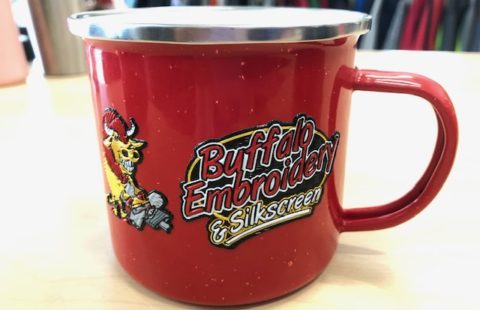I know you think I am biased, but before buying another disposable water bottle, just hear me out. A reusable water bottle is better for the Earth, saves you money and is better for your overall health.
Reusable Saves You Money
Did you know that Americans spend about as much money on disposable plastic water bottles each year as they do on engagement rings? $11 billion dollars. That is a lot of money being thrown away. An estimated 25 percent or more of bottled water is really regular tap water, sometimes purified, sometimes not. So you are really buying your own tap water. I just read the label on our local Tops brand water- it says right on it that it comes from our Erie county water supply. In the United States, 24 percent of bottled water sold is either Pepsi’s Aquafina (13 percent of the market) or Coke’s Dasani (11 percent of the market). Both brands are bottled, purified municipal water. Put a filter on your faucet and it is exactly the same thing. But free.
Sipping from a reusable bottle could save a whopping $550.00 a year (one disposable plastic water bottle daily at its average cost) compared to a one-time $10-$25 investment. One water pitcher filter can effectively replace as much as 300 standard 16.9-ounce bottles. So you can get great-tasting water without so much waste. Talk about refreshing. The average water pitcher filters 240 gallons of water a year for about 19 cents a day. Put in perspective, to get the same amount of water from bottled water would require 1,818 16.9-ounce water bottles a year – at an average cost of a dollar a bottle, that’s $4.98 a day. For about $10 each, you can purchase a reusable bottle, saving you hundreds of dollars a year on bottled water.The recommended eight glasses of water a day, at U.S. tap rates equals about $.49 per year; that same amount of bottled water is about $1,400.

Safety
If you think it is safer to drink from disposable water bottles still, maybe because you think that they are filtered more, think again. In the U.S., public water is regulated by the Environmental Protection Agency (EPA), which requires multiple daily tests for bacteria and makes results available to the public. The Food and Drug Administration, which regulates bottled water, only requires weekly testing and does not share its findings with the EPA or the public. Even under the more lax standards of the FDA, bottled water companies do not always comply with standardized contaminant levels. Alarmingly, the 1999 NRDC study found that 18 of the 103 bottled water brands tested contained, in at least one sample, “more bacteria than allowed under microbiological-purity guidelines.” Also, about one fifth of the brands tested positive for the presence of synthetic chemicals, such as industrial chemicals and chemicals used in manufacturing plastic like phthalate, a harmful chemical that leaches into bottled water from its plastic container. Bottled water companies, because they are not under the same accountability standards as municipal water systems, may provide a significantly lower quality of water than the water one typically receives from the tap. Tap water in this country, with rare exceptions, is impressively safe. It is monitored constantly, and the test results made public. You can control your home filter yourself. Replace it as recommended and it will do as good if not better than you are buying in disposable containers.
Recycling vs Reuse
We pitch into landfills 38 billion water bottles a year (in excess of $1 billion worth of plastic). They should get recycled, but many people choose to throw them away instead. Americans went through about 50 billion plastic water bottles last year, which means each person in America used about 167 of them, but only recycled 38 of them. Durable, lightweight containers are manufactured just to be discarded. Disposable water bottles are made of totally recyclable polyethylene terephthalate (PET) so they can be 100% recycled yet our recycling rate for PET is only 23%. Clearly this is a problem.
And if you are reusing your disposable water bottle instead of recycling it, eww. They are not meant for that. They are disposable. The mouths are not wide enough for you to clean properly. Harmful bacteria can accumulate inside as well as on the rim.
“In a 2002 study… researchers from the University of Calgary took 76 samples of water from water bottles of elementary school students; some of the bottles were reused for months on end without being washed.
They found that nearly two-thirds of the samples had bacterial levels that exceeded that of drinking water guidelines, which may have been the result of ‘the effect of bacterial regrowth in bottles that have remained at room temperature for an extended period,’ researchers wrote in the study…
“[T]he most likely source of enteric bacteria found in the students’ water bottles is the hands of the students themselves… Inadequate and improper hand washing after students have used the bathroom facilities could result in fecal coli forms in the classroom area.”
As soon as you drink from your water bottle, it is contaminated. You need to be able to clean it correctly. Our care and use instructions will help you keep your reusable bottles clean and healthy.

Energy Savings
Reusable water bottles save fossil fuels. If you fill one disposable plastic bottle a quarter of the way up with oil, it’s the amount needed to make it. A family of four switching to reusable bottles would save 27 gallons of oil a year. Making bottles to meet America’s demand for bottled water uses more than 17 million barrels of oil annually, enough to fuel 1.3 million cars for a year. And that’s not even including the oil used for transportation. Just one person switching to a reusable water bottle keeps 2,580 balloons of CO2 out of the air per year. By switching to reusable, you’ll feel better about your commitment to the Earth. The energy we waste using bottled water would be enough to power 190,000 homes.
Reusable is Prettier
Reusable water bottles just plain look better. You can give them as gifts or incentives. Put your logo on them for product promotions. Hand them out at marathons and trade shows. Almost every gift shop, bookstore and souvenir shop in the world has reusable water bottles for sale. You should be carrying your water bottle with you wherever you go. Shouldn’t it be used to promote your brand? Get your logo out in the hands of all your customers. They will want to reuse your water bottle when it looks good. And can keep them healthier.













